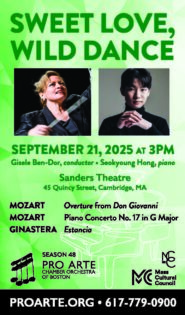NE Phil delivers intrepid program from Schoenberg to Lash

The New England Philharmonic and music director Richard Pittman returned to action Saturday night at Boston University’s Tsai Performance Center. The ensemble’s opening-night program featured a typically intrepid mix of pieces that spanned the last eleven decades beginning, chronologically, with Arnold Schoenberg’s Five Pieces for Orchestra.
Written in 1909 (and revised forty years later), Schoenberg’s score is one of several pieces that mark his departure from the strictures of Late Romanticism to the world of “free atonality.” Intense, roiling, epigrammatic—but still steeped in the gestures of the Austro-Germanic tradition Schoenberg never fully abandoned—the Five Pieces revel in fresh-sounding sonic and instrumental possibilities.
Saturday’s performance captured many of them, from the waltzing impetus that underlies the outer movements to the snappy brass licks that open the “Peripetia.” There was a strong sense of direction to the musical line in “Yesteryears,” the mournful second movement, and the shifting colors of the central “Summer Morning by a Lake” drifted hazily.
Throughout, the NEP, whose players are drawn from professional and amateur ranks, basked in the Five Pieces’ sonic effects: snarling brasses and woodwind trills in the opening “Premonitions” spoke clearly and the combination of tremolo strings with flutter-tongued winds near the end of the concluding “The Obligatory Recitative” shimmered.
The ensemble brought similar focus to bear in Gunther Schuller’s The Past is in the Present, which closed the night.
Essentially a memorial to Schuller’s wife, Marjorie, this threnodial 1994 essay is suffused with mournful gestures: expressive, chromatic solos over dense, sumptuous chords; searing outbursts that erupt suddenly and subside just as quickly; brash, furious rhythmic tattoos; chiming bells and the like.
On Saturday, Pittman drew a performance of real urgency from his forces. The opening movement built to a huge, tragic peroration. The song-like second floated nervously. Thundering percussion riffs and angular melodic lines offered some degree of angry catharsis in the brief third movement. And Erica Schiller’s alto flute solos soared in the elegiac finale.
Not everything on the evening’s docket was abstract or sober, though: preceding the Schuller came the Boston premiere of Hannah Lash’s God Music, Bug Music.
A winsomely enigmatic piece from 2011, its two movements develop identical materials. In the first, brass instruments pass around a five-note motive in tightly packed, contrapuntal spurts. Eventually, the rest of the ensemble joins in and the music becomes increasingly chromatic, ending in a driving blaze.
The second movement takes those same five notes but adapts them as a series of lyrical woodwind canons. Those episodes are interrupted by pungent, chromatic refrains in the rest of the orchestra which gradually infect the pentatonic figure. Ultimately the canon breaks down into a piping tone cluster as the piece ends.
The NEP played the latter with soul: the final, dissonant iteration of the second movement’s theme was bracing. Greater contrasts of rhythm and dynamics might have provided the first movement with a stronger sense of shape, but the overall character of Lash’s writing came across impressively.
Just as engaging was Hilary Purrington’s Above the last cloud, this year’s NEP Call-for-Scores winner. Finished in March, the work was originally written for the Sioux City Symphony and heard Saturday in its Boston premiere. Purrington’s score follows the development of a melodic idea as it emerges from a succession of high-string attacks, is transformed in various ways, and ultimately finds itself floating in the ensemble’s upper registers.
Conceptually, it’s fairly simple but Purrington’s technique carries the day. Her writing is largely diatonic, though judiciously colored by bent pitches and cluster-like sonorities. And her scoring is reminiscent of Benjamin Britten’s: clear and uncluttered, with some particularly striking moments for violas and harp.
Saturday’s reading was full of charm apart from a few tentative moments within the ensemble; still, the music’s dramatic structure, rhythmic energy, and expressive direction came over distinctively.
Ravel’s Concerto for the Left Hand was the night’s outlier. Completed in 1930 for the one-armed keyboardist Paul Wittgenstein, the Concerto – with its allusions to jazz and the blues, plus a few of Ravel’s greatest hits (hints of Bolero and Daphnis et Chloé pop up over its central part) – has long been a concert staple.
In pianist Jeffrey Swann, the NEP had a soloist for whom the work’s considerable demands held no terrors.
Swann’s account of his part was rich-toned and warm in the Concerto’s big opening section. He subtly teased out the music’s Debussy-like melodies and brought plenty of spunk to the taut march around its mid-point. Throughout, the pianist’s playing was carefully voiced, well balanced, and full of character.
Pittman led the NEP in an accompaniment that was murky if not quite crepuscular enough over the Concerto’s opening pages. But the orchestra capably embraced the jazzy lyricism in Ravel’s writing and positively swaggered in the big orchestral climax before the cadenza.
The New England Philharmonic presents “Story Telling: Annual Family Concert” 3 p.m. December 7. NEPhilharmonic.org
Posted in Performances


